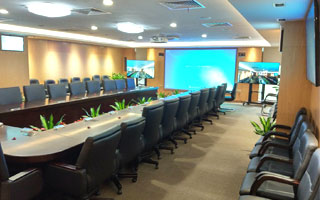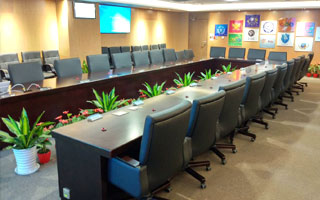莱湾科技教你怎样建设多媒体会议室
In addition to meeting the basic requirements of traditional meetings, a multimedia conference room should also feature an elegant atmosphere, excellent sound quality, and clear image presentations. It should be equipped, as needed, with simultaneous interpretation systems, voting and decision-making functions, as well as video conferencing systems.
The multimedia conference room system can be divided into several subsystems: projection and display system, conference sound reinforcement system, central integrated control system, multimedia audio-video system, and video conferencing system.
A multimedia conference room typically consists of large-screen displays, multimedia audio-video sources, sound systems, switching equipment, and a central integrated control system. Advanced DVD players, video recorders, and document/image presenters are used to project visuals through large-screen projectors. To enable efficient and real-time management, a central integrated control system is essential. It controls all in-room audio-visual equipment, signal switching, lighting, screen lifts, volume adjustments, and more—significantly improving work efficiency and simplifying complex operations. This allows users of all backgrounds to operate the system without needing specialized technical knowledge.

How to Design a Multimedia Conference System
1. How should the conference room's colors be arranged?
Another factor affecting image quality is the surrounding scenery and color scheme of the venue, including the tones of the tables and chairs. Generally, colors like white and black should be avoided, as these can cause undesirable effects such as glare and light loss. It is more appropriate to use light tones for the walls and furniture—for example, beige or light green walls and light coffee-colored tables and chairs. In southern regions, cool colors are preferred, while northern regions benefit from warm tones.
2. How should the lighting in the conference room be arranged?
Proper lighting is a basic requirement for any conference room. Cameras are typically equipped with automatic color balance circuits that provide natural colors. However, natural light from windows (with a color temperature of about 5800K) is higher than that of fluorescent lighting (about 3500K) or three-primary-color lighting (about 3200K). If both natural and artificial light sources are present, it can result in blue-tinted highlights and red-tinted shadows in the video image.
Since meetings can be held at any time—morning or afternoon—and natural light varies in intensity and color temperature throughout the day, natural light should be avoided in conference rooms. If artificial lighting is used, all windows should be covered with dark-colored curtains, and cool light sources such as RGB three-primary-color lights should be used for best results. Avoid using hot light sources.
3. How to reduce echo and noise in the conference room?
a. To control sound sources and enhance sound absorption, the room should be carpeted, and acoustic insulation materials should be installed in the ceiling and on the walls. Windows should use double-layer glass, and doorways should have soundproofing vestibules or buffer zones.
b. For effective sound absorption, the room typically needs carpeting, blackout curtains, acoustic ceiling panels, and door sealing treatments. However, excessive sound absorption should be avoided, as it can make the audio sound dry and lifeless. Before the audio signal reaches the power amplifier, equalizers and feedback suppressors should be used to enhance sound quality.
c. To reduce echo, minimize the number of microphones used in the room. The more microphones there are, the more likely echoes and background noise will be introduced.

Lineone Multimedia Conference System Solution
Lineone's multimedia conference system solution places strong emphasis on the scientific design of the system, advancement of the equipment, practical functionality, and reliability in usage, ensuring that the sound reinforcement system meets high standards. The selection of equipment and the design approach are forward-thinking, with all audio system design indicators meeting—and even exceeding—current national standards.
At the same time, as an important venue for various events, the safety and reliability of each system is undoubtedly the top priority. Sacrificing reliability in pursuit of high-end equipment may lead to poor outcomes and unnecessary losses.
Therefore, in designing the overall system, Lineone Technology drew on the design experience of many existing conference rooms as the foundation for this system. The multifunctional system is designed to fully meet all usage requirements. With a thorough understanding of future operational modes and functionality, the system is designed to include the following capabilities:
Meets the sound reinforcement needs of a multifunctional hall.
Supports large auditorium conference speech requirements.
As the stage in the multifunctional hall is often reconfigured, the conference system uses an infrared wireless solution for flexibility.
Supports audio and video switching needs within the multifunctional hall.
A centralized conference control system is implemented through a bi-directional centralized control interface located in the audio control room, allowing intelligent management of various audio, video, and switching equipment.
Supports playback of audio-visual content through dedicated equipment.
下一篇:莱湾科技成功签约北京美洲俱乐部



